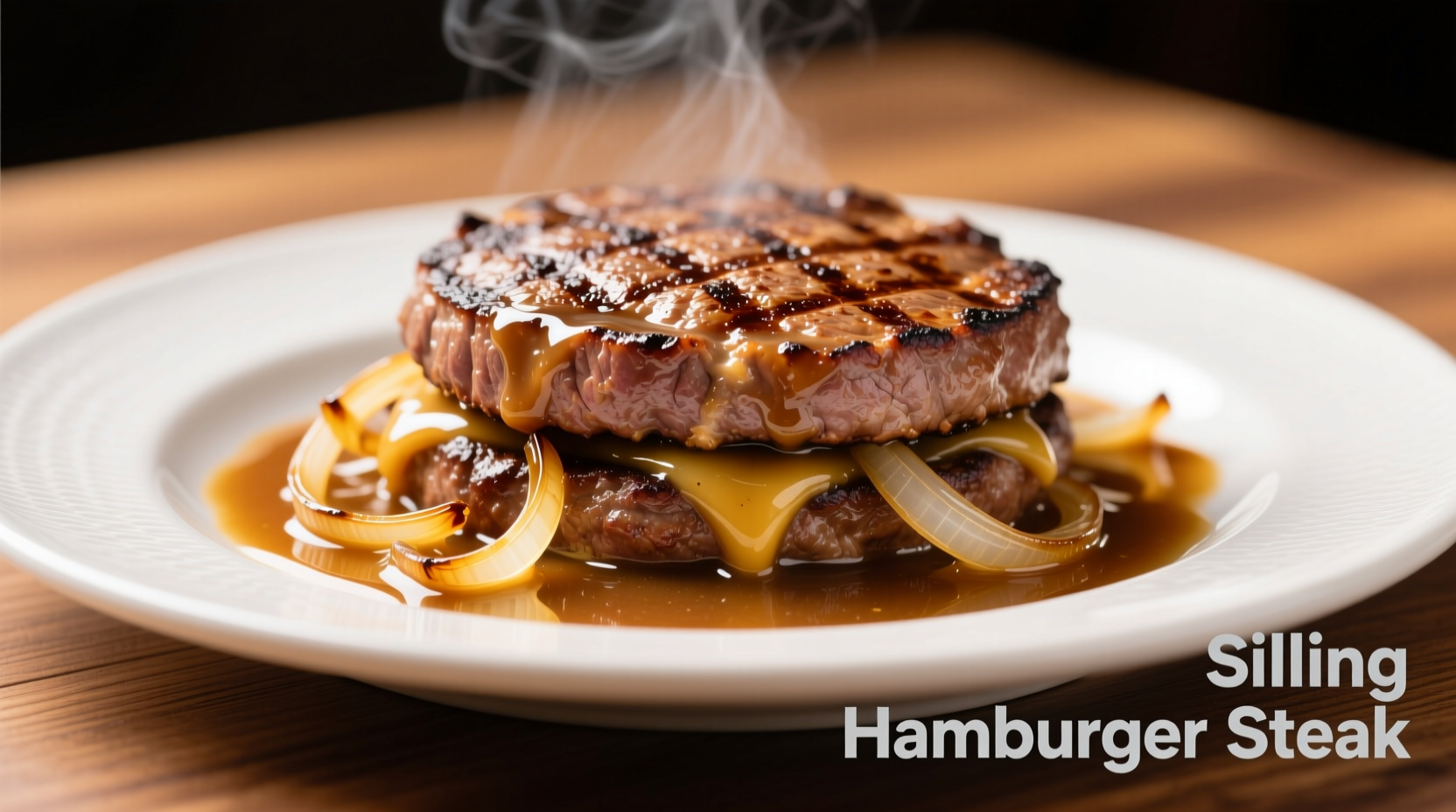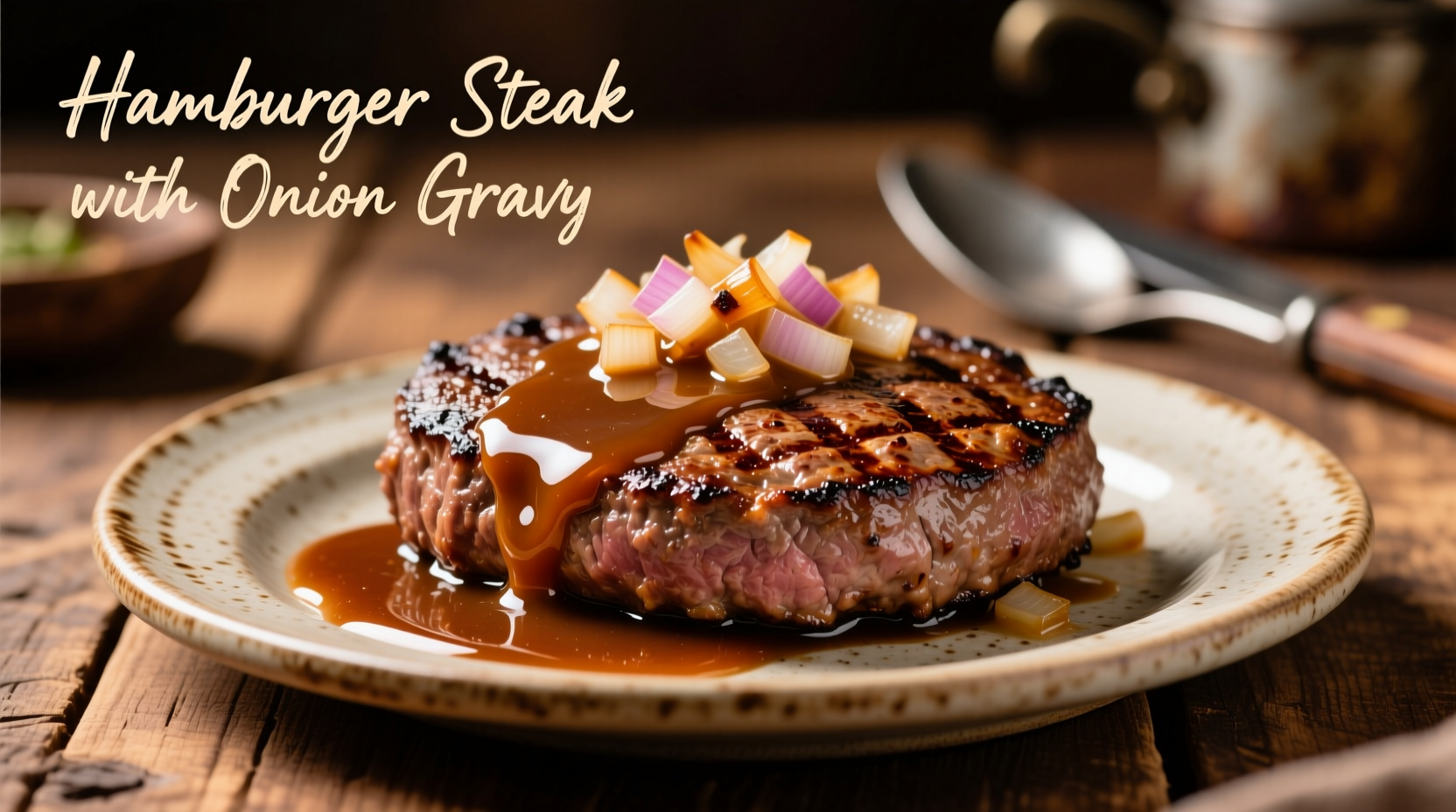Forget dry, flavorless meatloaf patties. The perfect hamburger steak with onion gravy balances juicy tenderness with deep savory notes that transform humble ground beef into a standout dinner. What separates this from ordinary burgers? Hamburger steak uses thicker patties (1½-2 inches) cooked gently without flipping excessively, preserving moisture while developing a rich crust. The magic happens when those fond-covered pan drippings meet slowly caramelized onions to create a gravy that's equal parts sweet, umami, and deeply satisfying.
Why This Recipe Works Every Time
Professional chefs know the secret to cohesive hamburger steak lies in temperature control and minimal handling. When ground beef warms beyond 65°F (18°C), fat begins melting out, causing patties to crumble. Keeping ingredients cold while assembling prevents this common failure point. The USDA Food Safety and Inspection Service confirms that ground beef reaches safe consumption at 160°F internal temperature, easily verified with an instant-read thermometer.
| Cooking Stage | Visual Cue | Internal Temp | Timing (1½" patty) |
|---|---|---|---|
| Rare | Red center | 120-125°F | 8-10 min |
| Medium | Pink center | 135-145°F | 10-12 min |
| Well Done | No pink | 160°F | 12-15 min |
Building Flavor Layers: The Onion Gravy Difference
Authentic hamburger steak gravy requires patience. Rushing the onion caramelization creates bitter notes instead of the sweet complexity that defines this dish. Food science research from the American Chemical Society explains that the Maillard reaction between amino acids and reducing sugars in onions creates over 150 flavor compounds when cooked slowly. This transforms sharp raw onions into sweet, jam-like strands that form gravy's foundation.

Step-by-Step Cooking Process
Prep Phase: Setting Up for Success
Chill your mixing bowl and hands under cold water before handling ground beef. Cold surfaces prevent fat from smearing, which would make patties dense. Form four 6-ounce portions using a kitchen scale for consistency, then gently shape into 1½-inch thick disks. Create a slight dimple in the center of each patty to prevent bulging during cooking.
Searing: Creating the Flavor Foundation
Heat 1 tablespoon oil in a cast-iron skillet over medium-high heat until shimmering. Place patties in the pan without crowding (work in batches if needed). Resist pressing down - this squeezes out precious juices. Cook undisturbed for 4-5 minutes until a deep brown crust forms. Flip once using a thin metal spatula and cook another 4-6 minutes for medium-well.
Gravy Development: Transforming Pan Drippings
Remove cooked patties to a warm plate, leaving drippings in the pan. Add 2 thinly sliced yellow onions and reduce heat to medium-low. Cook slowly for 20-25 minutes, stirring occasionally, until onions turn deep golden brown. Deglaze with ½ cup beef broth, scraping up all browned bits. Stir in 1 tablespoon Worcestershire sauce and 1 teaspoon Dijon mustard. Simmer until thickened to coating consistency.
Avoiding Common Pitfalls
Three mistakes ruin most home attempts at hamburger steak:
- Overmixing the beef - Handle ground beef minimally to maintain texture
- Rushing the onion cooking - Proper caramelization takes 20+ minutes
- Using lean beef - 80% lean provides necessary fat for flavor and moisture
The National Center for Home Food Preservation notes that ground beef's higher surface area makes it more susceptible to bacterial growth than whole cuts. Always refrigerate leftovers within two hours, and consume within three days for optimal safety.
Serving Suggestions That Elevate the Dish
Hamburger steak with onion gravy shines when paired with complementary sides that absorb the rich sauce. Creamy mashed potatoes provide the classic base, while roasted mushrooms add earthy depth. For a lighter option, serve over buttered egg noodles with steamed green beans. The dish's origins trace back to late 19th century American diners, where it offered an affordable alternative to expensive steak cuts - a practical solution that became a beloved comfort food tradition.
Variations for Dietary Needs
Adapt this recipe for different dietary requirements without sacrificing flavor:
- Gluten-free: Use tamari instead of Worcestershire sauce and cornstarch for thickening
- Lower sodium: Choose low-sodium broth and omit added salt
- Vegetarian option: Substitute lentils and mushrooms for beef (though this becomes a different dish)
Storage and Reheating Best Practices
Store cooled leftovers in airtight containers for up to three days. Reheat gently in a skillet with a splash of broth to restore moisture - microwaving dries out the meat. The FoodKeeper app from USDA and Cornell University confirms properly stored cooked ground beef maintains quality for 3-4 days in refrigeration. For longer storage, freeze portions with gravy for up to three months.











 浙公网安备
33010002000092号
浙公网安备
33010002000092号 浙B2-20120091-4
浙B2-20120091-4